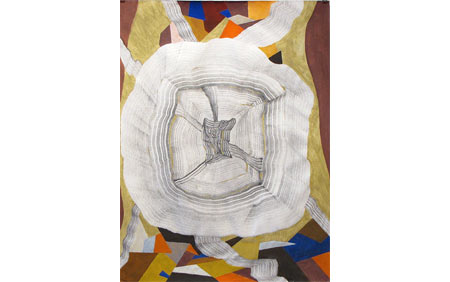Kevin P. Clarke / David Fought
at Ampersand International Gallery, San Francisco, California
 Kevin P. Clarke, 'Untitled,' 2000-2009, gouache, tempera, graphite in paper.
Kevin P. Clarke, 'Untitled,' 2000-2009, gouache, tempera, graphite in paper.
Illusionism might be said to be the operant principle of most historical art—not optical or photographic realism, with a sort of frozen view behind glass, but a concurrent psychological or perceptual trickery that is more complex than mere trompe-l’oeil. Two contemporary artists explore the creation of space and of esthetic meaning through abstract means alone in a show co-curated by Ampersand’s Bruno Mauro and Lori Gordon. It’s a reminder of how much we delight in being fooled, and in being in on the deception.
Kevin P. Clarke’s drawings and paintings build upon the repetition of a single unit or module—a stroke of broad graphite in his "Interstitial" drawings, or a length of wooden 2x2 (walnuts, Douglas fir) in his "Wooden Paradigm" sculptures; he adds more of these elements in different locations and orientations until something like a geometric organism or landscape emerges. In the drawings Clarke builds planes composed of parallel lines that are inspired by fabric and wood graining; the spaces generated by these planes “define the system and the relationship of the parts.” In the sculptures, Clarke restricts himself to lengths of wood attached at 90-, 45- and 22.5-degree angles. The beams appear randomly arranged at first, as if suspended in mid-collapse, or zero gravity, until we notice how the wood has been carved and glued, and the keen deliberation behind the frozen forms with their pleasing and implied volumes.
David Fought’s habit of staring at intriguing objects and of considering art as a kind of perceptual philosophy has led him to an ethos of not just making sculpture, but of savoring “the experience of [making, being with and observing] objects.” He adopts Robert Ryman’s strategy of inserting bit of wire (from coat hangers, in this case, sometimes painted, and sometimes not) into drilled holes in sheet-rocked walls, and adding drawn and painted lines or planes at tangents. When the shadows from track lighting are added, the wall seems to dissolve into white space or light, and the drawn and sculpted elements snap into focus as hovering virtual objects that change from convex to concave, or warp disconcertingly, as we change positions. The material-to-immaterial translations via form place the work in the realm of good craft and clever philosophical inquiry.
Illusionism might be said to be the operant principle of most historical art—not optical or photographic realism, with a sort of frozen view behind glass, but a concurrent psychological or perceptual trickery that is more complex than mere trompe-l’oeil. Two contemporary artists explore the creation of space and of esthetic meaning through abstract means alone in a show co-curated by Ampersand’s Bruno Mauro and Lori Gordon. It’s a reminder of how much we delight in being fooled, and in being in on the deception.
Kevin P. Clarke’s drawings and paintings build upon the repetition of a single unit or module—a stroke of broad graphite in his "Interstitial" drawings, or a length of wooden 2x2 (walnuts, Douglas fir) in his "Wooden Paradigm" sculptures; he adds more of these elements in different locations and orientations until something like a geometric organism or landscape emerges. In the drawings Clarke builds planes composed of parallel lines that are inspired by fabric and wood graining; the spaces generated by these planes “define the system and the relationship of the parts.” In the sculptures, Clarke restricts himself to lengths of wood attached at 90-, 45- and 22.5-degree angles. The beams appear randomly arranged at first, as if suspended in mid-collapse, or zero gravity, until we notice how the wood has been carved and glued, and the keen deliberation behind the frozen forms with their pleasing and implied volumes.
David Fought’s habit of staring at intriguing objects and of considering art as a kind of perceptual philosophy has led him to an ethos of not just making sculpture, but of savoring “the experience of [making, being with and observing] objects.” He adopts Robert Ryman’s strategy of inserting bit of wire (from coat hangers, in this case, sometimes painted, and sometimes not) into drilled holes in sheet-rocked walls, and adding drawn and painted lines or planes at tangents. When the shadows from track lighting are added, the wall seems to dissolve into white space or light, and the drawn and sculpted elements snap into focus as hovering virtual objects that change from convex to concave, or warp disconcertingly, as we change positions. The material-to-immaterial translations via form place the work in the realm of good craft and clever philosophical inquiry.

